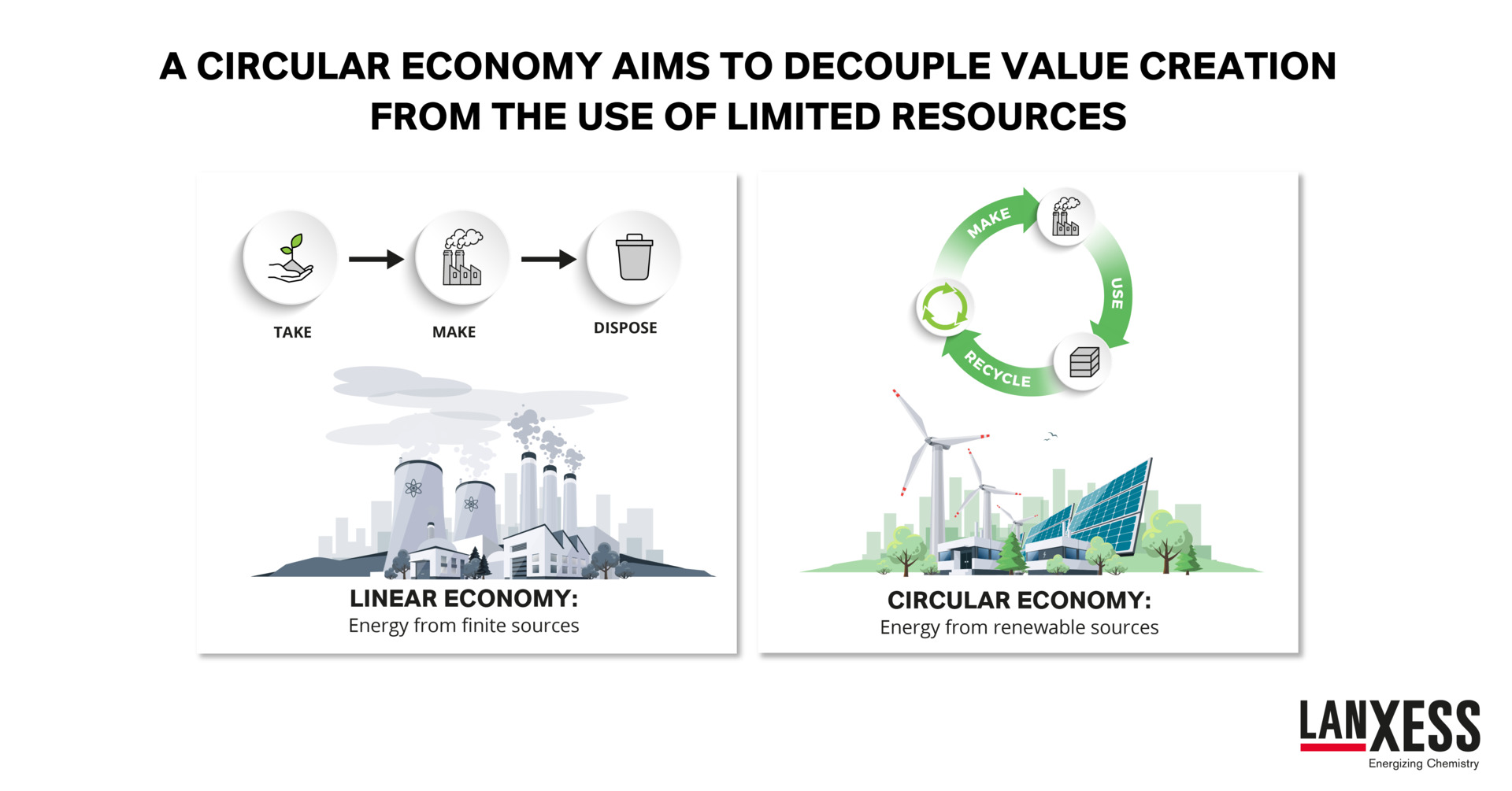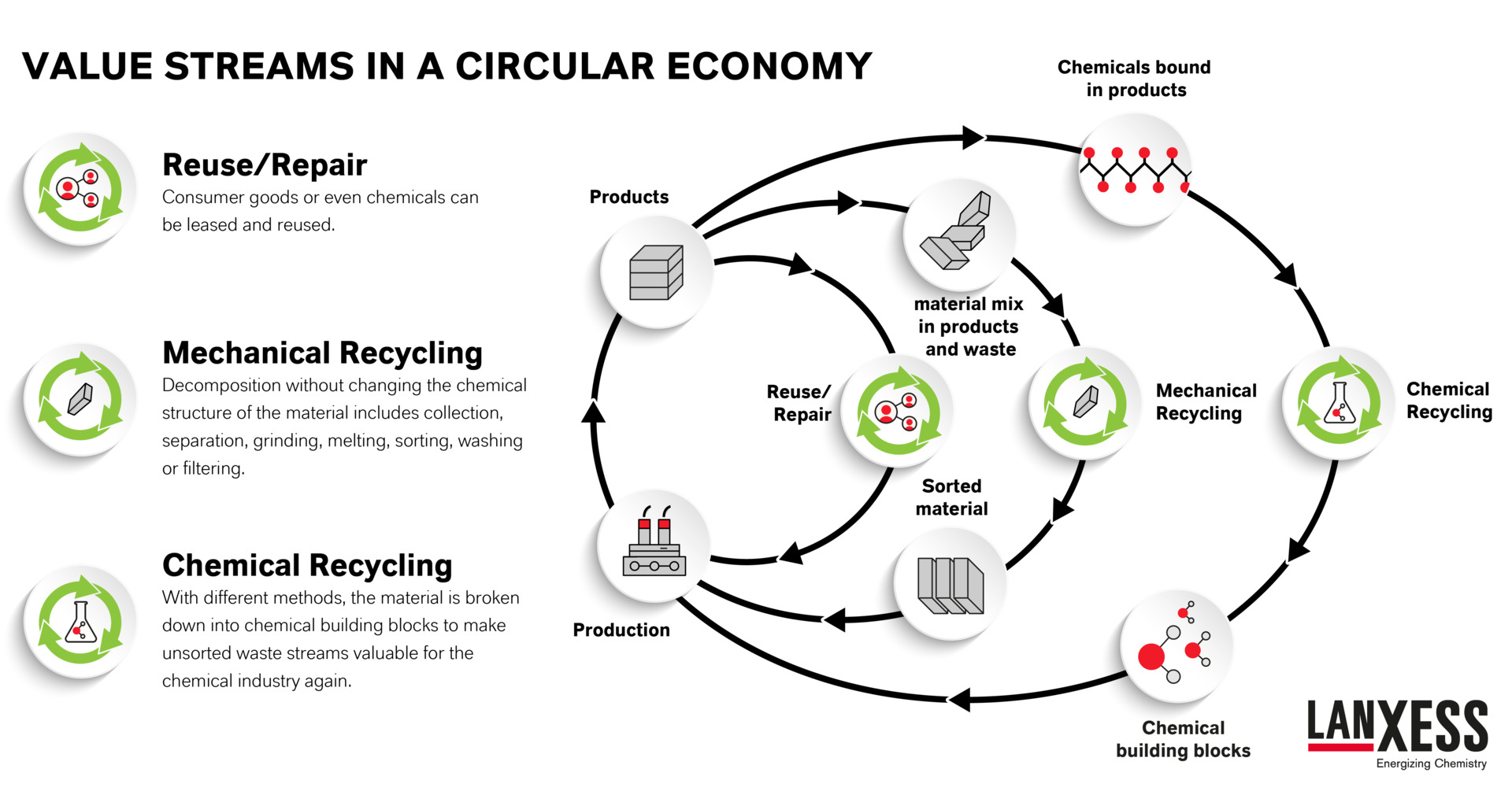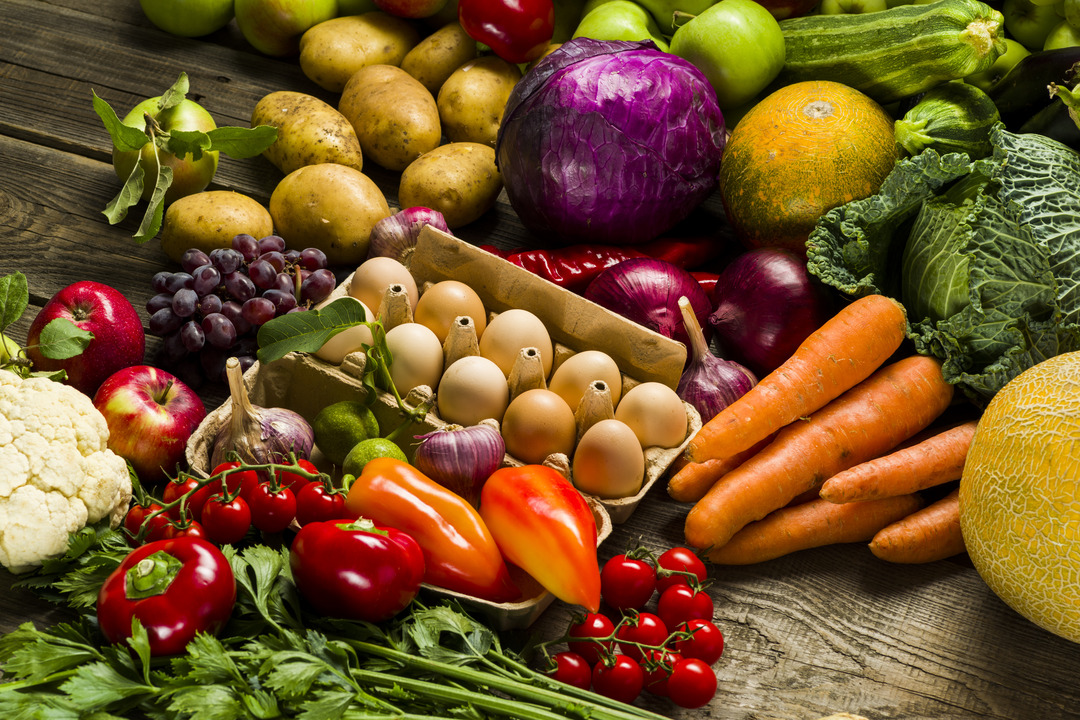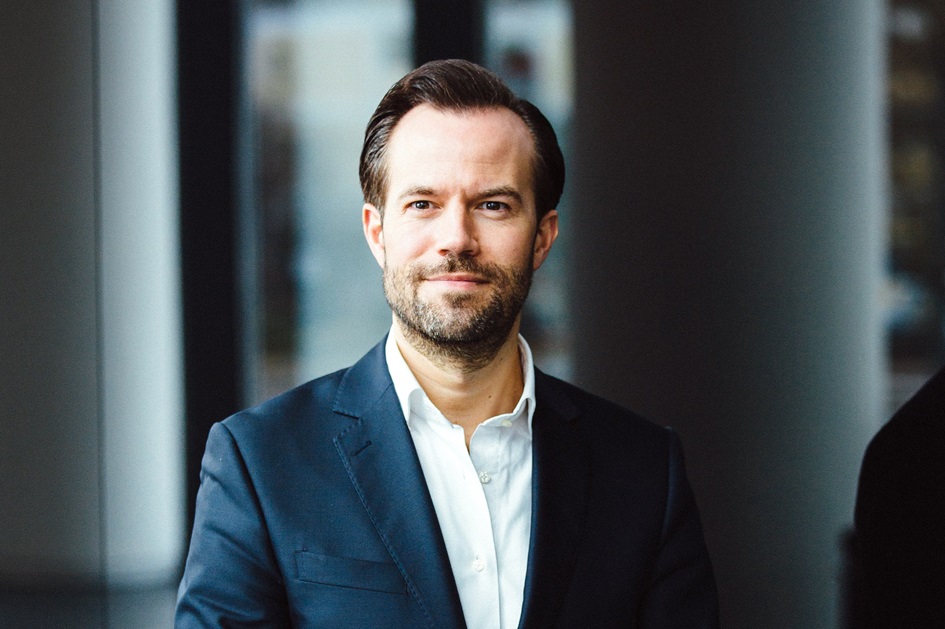
Circular Economy
Supporting the transformation of the society towards a sustainable, resource efficient and carbon neutral economy
The current set-up of the chemical industry is still heavily based on fossil resources. While the switch to selected circular approaches might be easy to realize, creating a real circular economy is a paradigm change that requires huge efforts from all involved stakeholders.
In a circular world, the industry will have to rethink well established processes to move from a linear take-make-use-dispose approach to a circular approach. The chemical industry is in the middle of long value chains. Today it gains its resources from the oil and gas industry, the mining industry and in parts from the agricultural sector. Raw materials are converted to basic chemicals and intermediates which then become functional chemicals like additives or materials. OEMs produce parts or final goods out of this materials which are used (and serve a purpose) and finally end-up as waste.
As a leading chemicals company we believe that the circular economy is about more than just recycling - it is about a transformation of the entire value creation system to become a sustainable and carbon neutral society.
This involves the entire product life cycle and can only happen in close cooperation in value networks, starting with the input of raw materials and ending with a resource efficient and environmentally friendly recycling mechanism for products. The Chemical Industry will be a strong enabler of circular solutions – in particular by chemical recycling of goods.
Chemical recycling - the conversion of waste into raw materials - is an important approach to addressing resource efficiency and avoiding emissions by returning waste to the value chain. Chemical recycling breaks down e.g. plastic waste into basic chemicals that can be used as virgin raw material for the manufacture of new products. Plastics in particular, most of which are based on fossil fuels, offer an important starting point for chemical recycling. LANXESS is currently exploring methods regarding chemical recycling.
LANXESS is actively supporting the transition of of the entire value creation systems towards a sustainable, carbon neutral and resource efficient society with its products and climate action such as our “Climate Neutral 2040” initiative. We believe that the circular economy, which includes a complete life-cycle approach is a key component of achieving a successful transition to a sustainable, low-carbon economy for Europe as well as contributing to meeting the Paris Agreement and the UN Sustainable Development Goals.
Additionally, LANXESS is committed to preventing the leakage of plastics into the environment. This is why we signed up to Operation Clean Sweep.
As a member of PlasticsEurope, LANXESS has also signed the voluntary commitment "Plastics 2030". Plastics 2030 aims to:
- Prevent leakage of plastics into the environment by increasing engagement inside and outside our industry
- Improve resource efficiency by accelerating innovation in the full life cycle of product
- Improve circularity of plastics packaging by reaching in 2040 100 % reuse, recycling and/or recovery of all plastics packaging in the whole EU (60 % by 2030).
Different stages of circularity and the role of chemical recycling
Reuse and repair
Consumer goods or even chemicals (e.g. solvents) can be leased and reused. Many new business models like reuse of food packaging are currently under development.
Mechanical recycling
Mechanical decomposition without changing the chemical structure of the material. Mechanical recycling has been applied for long time and includes collection, separation, grinding, melting, sorting, washing or filtering. The challenge why it is not suitable in every case is the degradation of the material during life-time, mainly through oxidation. In addition, only clean and sorted plastics are fit for mechanical recycling.
Chemical recycling
Chemical recycling is expected to play a major role in a circular economy. The general interest of chemical recycling is to gain monomers or petrochemical feedstock and make unsorted waste streams valuable for the chemical industry again. With different methods, the material is broken down into chemical building blocks. Methods include:
- Depolymerization: Conversion of macromolecules into their constituent parts - monomers. The value of the monomers is maintained.
- Pyrolysis is the process of light thermal degradation - the polymer is split into monomers and often back into basic chemicals. It is feasible for unsorted and contaminated waste streams. The output material can be used as feedstock for chemical value chains again.
- Gasification is the process of heavy thermal degradation. It is suited for unsorted, even highly contaminated waste streams. Organic materials are converted into so-called syngas or light feedstock. Gasification enables the production of chemical materials back from the scratch.
Chemical recycling can process waste that is too complex or too contaminated for mechanical recycling.
Climate-neutral and circular products
We want to help transform the entire value creation system into a resource-efficient and climate-neutral society. On the road to climate-neutral and circular products, we are focusing on three partially overlapping action areas. LANXESS AG
LANXESS AGLANXESS products are sold almost exclusively to industrial customers. Only they or customers even further downstream use them to produce end products for a wide range of markets. With regard to completing cycles, this means that there are sometimes very long periods between production and the end of our products’ lifecycles. As a first step, we are therefore focusing on what we as a company can control: We are working to ensure the “recyclability” of all our products so that they are suitable for environmentally friendly recycling. In order to understand which “recyclability” requirements to impose on our products, it is important to analyze the function of our molecules in their final use and in which cycles (biological or technical) they circulate.
Examples for projects and initiatives
Polystyrene Loop
LANXESS is currently working with partners to research innovative methods of chemical recycling. This includes the "Polystyrene Loop" project, for example. This novel process makes it possible to completely recycle used flame-retardant polystyrene-based insulating panels. Not only the styrene from the polymer but also the bromine contained in the flame retardant is recovered. The quality of the recycled polymer corresponds to the original material. And the recovered bromine can also be used again to produce sustainable flame retardants.
Fiber-reinforced thermoplastic composites with recycled polycarbonate
LANXESS subsidiary Bond-Laminates is currently developing a new product range for its Tepex-branded continuous-fiber-reinforced thermoplastic composites. Half of the matrix for the new semi-finished products consists of recyclates originating from the recycling of reusable polycarbonate water bottles. The flexural strength and stiffness are at least as good as any new product already on the market.Pocan ECO grades
The polyester blend series Pocan ECO contains a specially recycled post-consumer PET. This makes it possible to produce premium finished parts, such as white goods, whose properties and quality are very close to those of virgin material.Durethan Eco polyamide product range with fibers from waste glass
LANXESS has launched three new polyamide 6 compounds with recycled fibers manufactured from waste glass making up 30 %, 35 % and 60 % by weight respectively. Ecocycle, an independent inspection company, has examined the amount of recycled material in each compound and the long-term use of the glass waste stream using the mass balance method and awarded an ecoloop certificate in accordance with ISO 14021:2016. The glass comes from waste left over from glass fiber production (post-industrial recycling).LANXESS has signed a cooperation agreement on the circular economy with the Karlsruhe Institute of Technology (KIT) in the field of thermochemical recycling. These processes offer an alternative to limited and costly mechanical processes and open up the possibility of generating valuable raw materials for the chemical industry from waste streams.
The collaboration aims to identify recycling opportunities for additive-containing plastics using pyrolysis. The aim of the project is to obtain scientific fundamentals for the thermochemical conversion of waste containing plastics and to optimize the processes for transfer to industrial scale.
A recently published KIT study shows that chemical recycling processes outperform other processes in terms of recycling costs and carbon efficiency.
LANXESS is a founding member of the BDI Circular Economy initiative - as one of only a few companies in the chemical industry. The aim is to identify technological potential and define the necessary framework conditions for a functioning Circular Economy. The initiative aims to be a platform for the exchange of ideas between industry and politics, science and society in order to jointly develop instruments to promote the recycling raw materials market and tap potential for waste reduction.
LANXESS joins the International Sustainability and Carbon Certification initiative.
ISCC is a multi-stakeholder initiative governed by an association with over 140 members. The aim of the association is the global roll-out and further development of a sustainability standard covering the entire value chain from feedstock up to the OEM or brand owner. The LANXESS polymer compounding at our site in Krefeld-Uerdingen and the glass fiber production in Antwerp have recently already been certified according to ISCC. LANXESS will actively participate in the further development of ISCC standards on the way towards a sustainable, carbon neutral and circular economy.
WBCSD Factor10 initiative
To achieve a circular economy, eco-efficiency of materials must improve by more than a factor of 10. This insight gave birth to the "Factor10" initiative of the World Business Council for Sustainable Development (WBCSD) - and LANXESS is part of it together with over 30 companies from more than 15 industries and countries. Factor10 produces metrics, tools and novel insights that enable circular transitions.
Circular Transition Indicators framework (CTI v3.0)
The latest version of the Circular Transition Indicators framework (CTI v3.0) by @WBCSD – World Business Council for Sustainable Development helps companies assess their circular progress in a simple, transparent and comparable way. The framework provides insights that show how business can take action to reduce waste, increase resource efficiency and report on carbon emission reductions.
The new version includes:
- method for calculating reduced GHG emissions from #circular practices
- two new indicators for lifetime extension
- best practices on taking action at scale.
LANXESS is a founding member of the Circular Cars Initiative of the World Business Council for Sustainable Development (WBCSD).
The Circular Cars Initiative (CCI) is a partnership between stakeholders from the automotive ecosystem (e.g. industry, policymakers and fleet purchasers) seeking to eliminate or minimize total lifecycle emissions with a special emphasis on manufacturing emissions. The initiative’s overarching goal is to develop a concept for an automotive system that is convenient, affordable and firmly grounded within a 1.5 °C climate scenario by 2030.
Watch the replay of our “linkedIn live” session “How vehicles become climate-neutral”: more
More about the CCI: more
More about the CEP: more
"LANXESS participates in the cross-value chain cooperation within the framework of the project "Circular Economy as an innovation driver for a climate-neutral and resource-efficient economy" (CEWI).
The aim of the collaborative project is to accelerate the transformation towards a climate-neutral and resource-efficient economy in the building and automotive sectors through Circular Economy approaches. CEWI is carried out by the 2° Foundation, the Wuppertal Institute for Climate, Environment, Energy and WWF Germany and funded by the Federal Republic of Germany, Grantor: Federal Ministry for the Environment, Nature Conservation and Nuclear Safety based on a resolution of the German Bundestag."
Worldwide, half of CO2 emissions are directly or indirectly attributable to raw materials extraction and processing (IRP Global Resources Outlook 2019). The German government bundles its efforts for a combined view of climate and resource protection in the "Climate Protection Program 2030" and the "German Resource Efficiency Program." With the new "Circular Economy Action Plan" in the course of the "Green Deal", the EU Commission describes the circular economy as an indispensable pillar on the way to a decarbonized economy.
The project starts here and contributes to the entrepreneurial implementation of the circular economy in Germany. It activates and accompanies companies and stakeholders in the development of innovative, cross-sector pilot projects. The projects are designed to address key CO2 reduction potentials, reduce primary raw material extraction and waste, and initiate systemic changes toward a circular economy. It is planned to exchange information with policymakers on obstacles and the need for research and funding.
The work in the CEWI project builds on existing projects and initiatives and complements their approaches and results.
>>more









